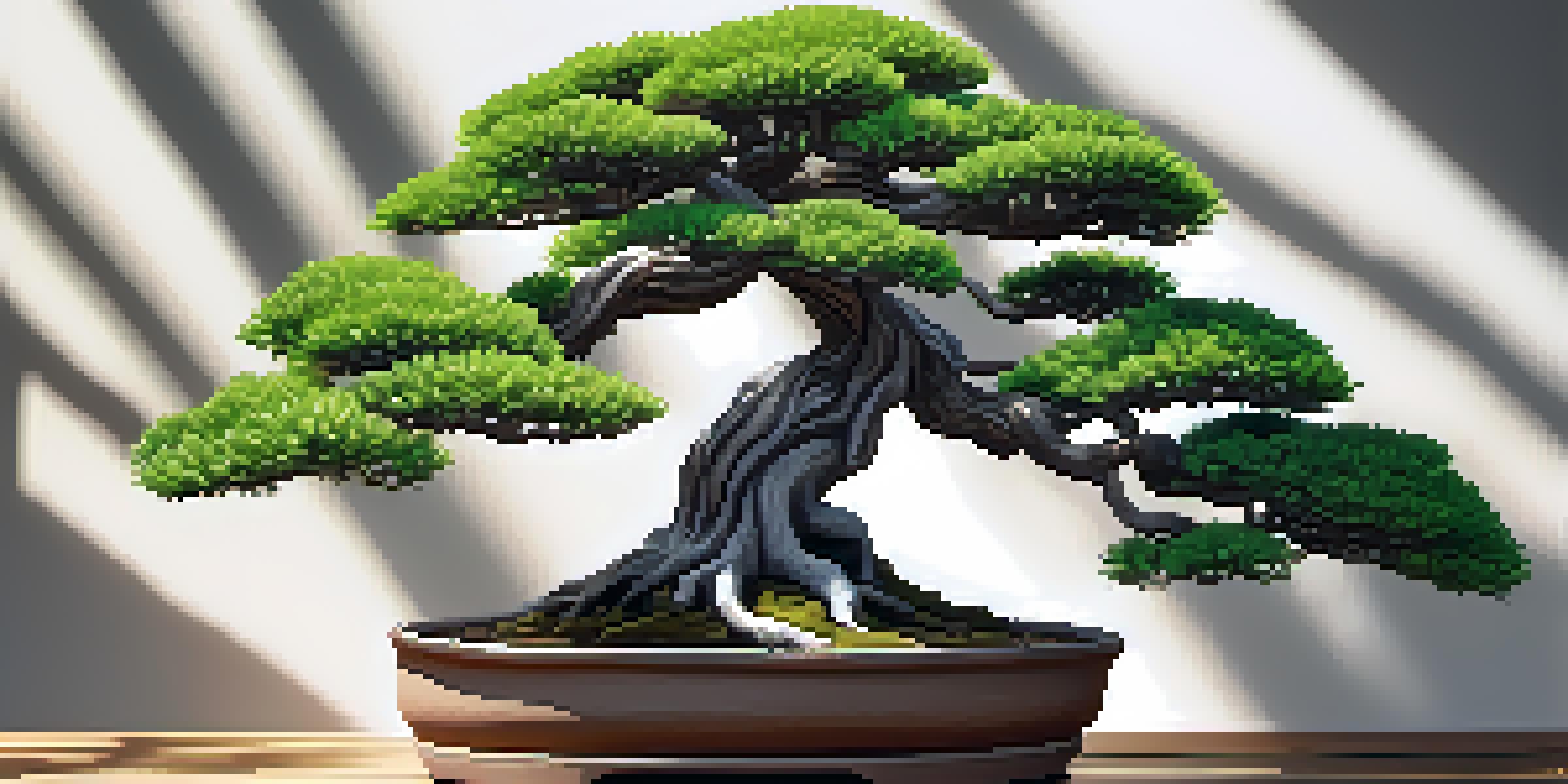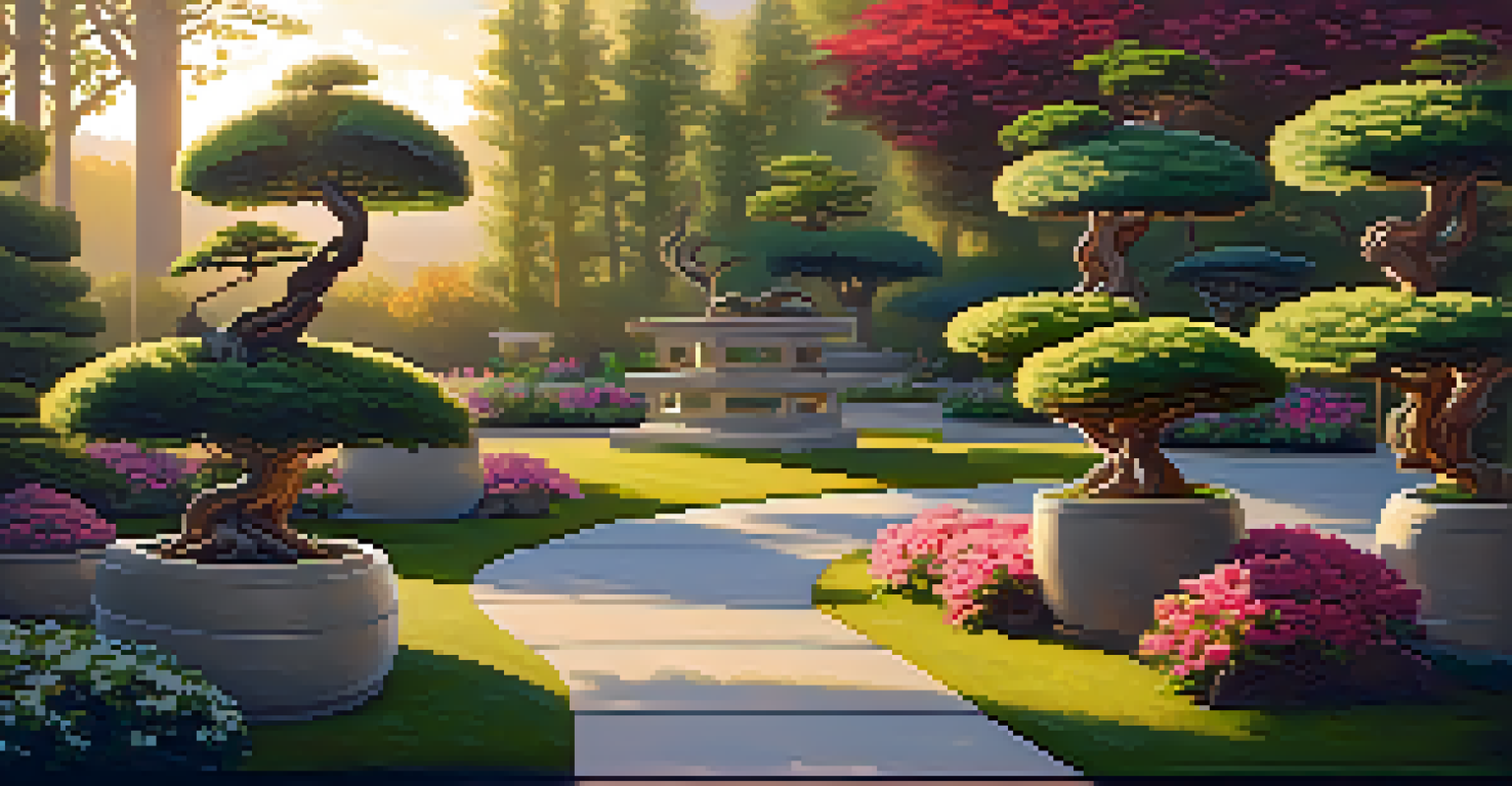Styling Your Bonsai: Techniques for Aesthetic Appeal

Understanding the Art of Bonsai Styling
Bonsai is more than just growing a small tree; it's an art form that combines horticulture and creativity. The goal of bonsai styling is to create a miniature tree that mimics the grandeur of a full-sized tree in nature. This requires not only skill but also an appreciation for the aesthetics that make a bonsai truly captivating.
The creation of a bonsai tree is a balance between nature and art, reflecting the beauty of both.
When styling your bonsai, you should consider the tree's natural growth patterns and the desired aesthetic. Different species lend themselves to various styles, so understanding their characteristics is crucial. A well-styled bonsai can evoke feelings of peace and serenity, connecting you to nature in a unique way.
Ultimately, bonsai styling is a personal journey. It's about expressing your vision and artistic flair while respecting the tree's natural form. As you embark on this craft, remember that each bonsai reflects its owner's personality and creativity.
Choosing the Right Bonsai Species
Selecting the right species is fundamental to the styling process. Some trees, like the Ficus or Juniper, are more forgiving and grow well in various conditions, making them excellent choices for beginners. Others, such as the Japanese Maple, require more attention to detail and specific environmental factors.

Consider your local climate and the indoor or outdoor setting for your bonsai. Certain species thrive better indoors, while others need the outdoor elements to flourish. Researching the needs of different trees helps you make an informed decision, setting the stage for successful styling.
Bonsai as an Art Form
Bonsai styling blends horticulture and creativity to create miniature trees that reflect the grandeur of nature.
Once you've selected a species, you can begin to explore the various styling techniques that will highlight its unique features. Remember, the goal is to enhance the natural beauty of the tree while maintaining its health and vitality.
Essential Tools for Bonsai Styling
Having the right tools makes all the difference in bonsai styling. Basic tools include pruning shears, wire cutters, and special bonsai wire, which helps shape the branches. Investing in high-quality tools not only makes the process easier but also ensures the health of your bonsai.
To nurture a bonsai is to nurture a part of yourself, as each tree tells a story of growth and patience.
Pruning shears are essential for maintaining the shape of your bonsai, allowing you to remove unwanted growth. Wire cutters come into play when it's time to adjust the branches, while bonsai wire provides the support needed to guide branches into desired positions. Each tool serves a purpose, contributing to the overall artistry of your bonsai.
As you gain experience, you might find yourself adding more specialized tools to your collection. However, starting with the basics is perfectly fine and will serve you well as you begin your bonsai journey.
Pruning Techniques for Aesthetic Growth
Pruning is one of the most critical aspects of bonsai styling. It's essential to understand when and how to prune your tree to encourage healthy growth and maintain its shape. Regular pruning helps to create a balanced structure, ensuring that your bonsai looks visually appealing from all angles.
There are two main types of pruning: maintenance pruning and structural pruning. Maintenance pruning involves trimming back new growth to maintain the desired shape, while structural pruning focuses on removing branches that disrupt the overall form of the tree. Both techniques are vital for achieving a well-styled bonsai.
Choosing the Right Species Matters
Selecting an appropriate bonsai species based on your climate and environment is essential for successful growth and styling.
As you prune, always keep in mind the tree's natural growth patterns. Don't hesitate to step back and assess the overall look of your bonsai, ensuring that each cut contributes positively to its aesthetic appeal.
Wiring Techniques for Branch Manipulation
Wiring is a crucial technique for shaping your bonsai branches and trunk. By carefully wrapping wire around the branches, you can train them to grow in a specific direction, creating the desired silhouette. It's important to select the right gauge of wire to avoid damaging the tree while still providing adequate support.
When wiring, patience is key. The wire should be applied gently, ensuring it doesn't cut into the bark as the branch grows. After a few months, you can remove the wire, allowing the branch to maintain its new shape. This process can transform your bonsai, giving it a unique character.
Remember to check on your wired branches regularly. If you notice any signs of stress or damage, be prepared to adjust the wire or remove it altogether. The goal is to create a beautiful bonsai that thrives for years to come.
Creating Depth with Layering Techniques
Layering is a technique that adds depth and dimension to your bonsai, making it visually striking. This involves creating multiple tiers of branches that mimic the natural layering of trees found in the wild. By carefully selecting which branches to keep and which to remove, you can achieve a harmonious look.
As you layer your bonsai, consider the overall composition. Aim for balance and symmetry while still allowing for some irregularity, which adds to the natural feel. Layering not only enhances visual interest but also contributes to the tree's overall health by allowing light to reach the inner branches.
Regular Maintenance is Key
Consistent care, including pruning and monitoring for pests, is crucial to preserving the beauty and health of your bonsai.
Don't be afraid to experiment with different layering styles. Each bonsai is unique, and your personal touch will make it one-of-a-kind, reflecting your artistic vision.
Maintaining Your Bonsai for Lasting Beauty
After styling your bonsai, regular maintenance is crucial to preserve its beauty. This includes watering, fertilizing, and ensuring it receives adequate sunlight. A well-cared-for bonsai will continue to thrive and evolve, showcasing the results of your hard work.
Monitoring the health of your bonsai is essential. Keep an eye out for pests and diseases, as these can quickly detract from its aesthetic appeal. By addressing any issues promptly, you can ensure your bonsai remains a stunning centerpiece in your home or garden.

Finally, remember that bonsai styling is an ongoing process. As your tree grows and changes, so too will its styling needs. Embrace the journey, and enjoy watching your bonsai flourish over time.